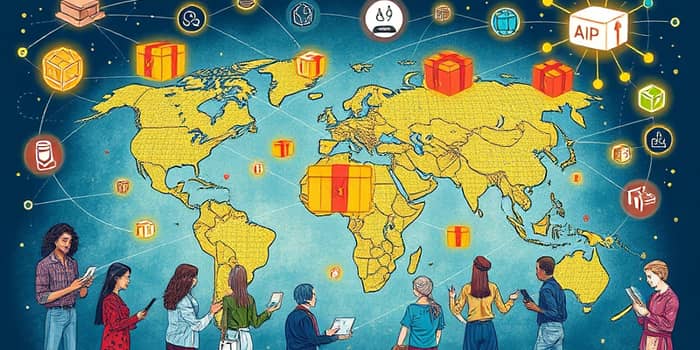In an era defined by connectivity, the story of e-commerce is one of relentless innovation, soaring growth, and transformative opportunity. Businesses and consumers alike find themselves at the intersection of technology and trade, navigating a landscape shaped by mobile adoption, AI insights, and shifting expectations. This article offers an authoritative guide to thriving in the modern marketplace, blending inspiration with actionable strategies.
The Global Growth and Impact
The numbers tell a compelling tale: global retail e-commerce sales are projected to exceed $6.4 trillion in 2025, climbing at a steady 6.8% year-over-year. By 2030, digital commerce could represent nearly 24% of all global retail, with total sales approaching $9 trillion. In the United States alone, online retail is on track to surpass $1.3 trillion in 2025, equating to roughly 16% of total retail sales.
This unparalleled growth extends beyond B2C. B2B digital commerce, valued at $32.1 trillion in 2025, is outpacing consumer channels with a projected 14.5% CAGR. Together, B2B and B2C e-commerce will comprise a $71 trillion market by 2030, underscoring the critical importance of mastering both segments.
Technological Transformation and Consumer Experience
At the heart of this evolution lies technology. From AI-driven personalization to micro-fulfillment centers, businesses are reinventing every stage of the shopping journey. Over 86% of B2B sellers now rely on advanced analytics for personalized offers, while mobile commerce is set to reach $2.51 trillion in 2025.
Consider these key innovations:
- Seamless omnichannel experience: Integrating physical stores, websites, and social platforms creates unified customer journeys.
- AR/VR and immersive shopping: Virtual try-on and 3D product demos enhance decision making and reduce returns.
- AI-powered inventory management: Real-time tracking and dynamic pricing optimize stock levels and margins.
Social commerce is another game-changer: global revenue from shopping via social media reached $683.9 billion in 2024, rising nearly 20% year-over-year. Brands that harness user-generated content and influencer partnerships gain a direct line to engaged audiences.
Strategies for Success in 2025 and Beyond
To master the modern marketplace, businesses must adopt a multi-pronged approach that aligns with evolving consumer demands and technological capabilities. Below are five core strategies:
- Mobile-first user journeys: Prioritize responsive design, one-click checkout, and app-based loyalty to capture the majority of smartphone transactions.
- Data-driven personalization: Leverage customer insights to tailor product recommendations, promotions, and content across channels.
- Sustainable supply chain solutions: Embrace eco-friendly packaging, carbon footprint tracking, and ethical sourcing to meet ESG expectations.
- Strategic marketplace positioning: Balance direct-to-consumer models with major platforms like Amazon, eBay, and niche marketplaces to maximize reach.
- Community-driven loyalty ecosystems: Cultivate brand advocates through subscription programs, VIP memberships, and exclusive experiences.
For many organizations, the choice between a proprietary storefront and marketplace presence is no longer binary. A hybrid model, supported by robust analytics and fulfillment networks, ensures agility and broad customer access.
Overcoming Challenges and Building Resilience
Rapid expansion brings complexity. Rising customer acquisition costs, logistics bottlenecks, and data security concerns demand proactive solutions. Here are practical steps to tackle these obstacles:
- Invest in automation: Use robotics and AI for warehouse operations to increase speed and reduce manual errors.
- Implement multi-layered security: Protect customer data with encryption, tokenization, and regular compliance audits.
- Optimize returns management: Offer clear policies, prepaid labels, and local drop-off points to minimize reverse logistics costs.
- Negotiate platform fees: Build strategic partnerships with marketplaces to secure volume discounts and advertising credits.
Additionally, regulatory pressures—cross-border taxes, digital tariffs, and privacy laws—require a dedicated governance framework. Companies that establish clear compliance protocols will avoid costly disruptions and strengthen customer trust.
Key Metrics at a Glance
Future Outlook: Innovation on the Horizon
Looking ahead, the e-commerce frontier promises even more transformative shifts. Blockchain-based payment systems, AI shopping assistants, and micro-fulfillment robotics will redefine speed and transparency. As digital buyers approach 3 billion by 2027, emerging markets with high mobile penetration will lead adoption curves.
The subscription economy will continue to strengthen relationships, particularly in B2B, where recurring services can account for $1.5 trillion in the U.S. by 2025. Meanwhile, sustainability initiatives—ranging from plastic-free packaging to carbon-neutral shipping—will become standard competitive differentiators.
Ultimately, success in the modern marketplace hinges on a willingness to embrace change. By fostering a culture of innovation, investing in cutting-edge technologies, and prioritizing customer-centricity, businesses can navigate uncertainty and seize the boundless opportunities of the digital age.
Conclusion
The evolution of e-commerce is more than a technological shift; it is a paradigm change in how we buy, sell, and connect. From global growth trajectories to hyper-personalized experiences and sustainable practices, mastering this complex ecosystem demands vision, agility, and strategic foresight. Those who rise to the challenge will not only capture market share but also shape the future of commerce itself.
References
- https://capitaloneshopping.com/research/ecommerce-statistics/
- https://www.sellerscommerce.com/blog/ecommerce-statistics/
- https://www.mordorintelligence.com/industry-reports/united-states-ecommerce-market
- https://www.invespcro.com/blog/online-retail-statistics-and-trends/
- https://www.shopify.com/blog/global-ecommerce-sales
- https://www.census.gov/retail/ecommerce.html
- https://www.statista.com/outlook/emo/ecommerce/worldwide
- https://www.trade.gov/ecommerce-sales-size-forecast










